Let’s build abuse victims’ memorial and send for the Pope to unveil it
And they must see, in front of their eyes, a tangible and permanent reminder that the people of Ireland will no longer tolerate any other efforts at cover-ups
SO, our Bishops have gone to meet the Pope. They are going to brief him — again — on the scandal and shame that has befallen the Irish church, and it is rumoured he or his advisers may have some views about necessary reorganisation within the institution here. It is also being reported that Pope Benedict may write a letter to the people of Ireland, expressing his sorrow at the terrible sins committed against children over many decades in Ireland.
Will it amount to an apology, I wonder? Will it be the sort of apology that deserves what the Catholic church raised us up to call absolution? In other words, will it be full, sincere, explicit?
Will it be accompanied by a willingness to do penance and to atone? Will it be accompanied also by an absolute determination never to sin again?
But why send the people of Ireland a letter, to be read out by others from distant pulpits, if you really wish to express true sorrow? Doesn’t the awfulness of the sins committed merit a lot more than a letter? Surely our bishops should be asking the Pope — and not too politely either — to come and speak to the people of Ireland, and say sorry in person. And while he’s here, he should be asked to pay a solemn visit to the memorial being erected to the people who suffered from the abuse perpetrated over decades by religious orders in Ireland.
In fact, Pope Benedict could be asked to open the memorial because it hasn’t been built yet. I’m beginning to wonder if someone has forgotten there is a commitment to that memorial, and that commitment is a solemn one.
“Lest we forget.” That’s a phrase that became popular after the end of the First World War and is inscribed on countless memorials all over the world. That phrase had many meanings, but two were more important than any others. Let us never forget the men who died in that terrible war — and let us never forget it was supposed to be the war that would end all wars.
In fact, if you google the phrase “lest we forget” (as I did over the weekend) it has been adopted by all sorts of causes in the 92 years since the First World War ended. There are online museums about American slavery that frequently use the phrase and it appears again and again in memorials to the Jewish Holocaust.
It’s the main reason, I believe, why we must proceed, and as quickly as possible, to build and open a memorial to all those who suffered and died in the period of institutional abuse that was such a shameful part of our history. Nearly a year has elapsed since publication of the Ryan report and already there are some signs that it is beginning to fade in the public memory.
What’s even more worrying is that it appears to be the case that some of the survivors, and the groups representing them, no longer seem to want a memorial. For reasons I don’t understand, some of them have made suggestions that the money proposed to be spent on a memorial could be diverted to other uses. It has even been proposed that the cost of the memorial could be sent to Haiti instead.
As a citizen, I believe that’s a mistake, and a false choice. I recognise fully that I don’t have the right to tell survivors what they should do, but I believe passionately that if there is not a permanent and highly visible reminder of the decades of abuse they suffered, that will only facilitate another effort to airbrush it out of history.
The very first recommendation of the Ryan report was this: “The following words of the special statement made by the Taoiseach in May 1999 should be inscribed on a memorial to victims of abuse in institutions as a permanent public acknowledgement of their experiences. It is important for the alleviation of the effects of childhood abuse that the State’s formal recognition of the abuse that occurred and the suffering of the victims should be preserved in a permanent place: ‘On behalf of the State and of all citizens of the State, the Government wishes to make a sincere and long overdue apology to the victims of childhood abuse for our collective failure to intervene, to detect their pain, to come to their rescue.’ ”
The Government accepted this recommendation and announced (among a host of other actions arising from the report) that a dedicated budget of up to €500,000 would be set aside for the project. A committee was to be established (by September 2009 — I assume that has been done, although I’ve heard nothing about it) to consider the views of survivors about what type of memorial they would wish to see and to consider arrangements for a national day of remembrance and solidarity. A sum of €15m has been allocated by the Government for this year to help towards implementation of the Ryan report recommendations. So there is no reason not to go ahead with a memorial.
But there are several very pressing reasons why it must be built. Abusers, and those who covered up abuse to protect institutions, must be constantly reminded of what they have done. And they must see, in front of their eyes, a tangible and permanent reminder that the people of Ireland will no longer tolerate any other efforts at cover-ups.
But apart from that, there are survivors and their families. People who still carry the scars of everything they suffered, people whose bravery and pain are still visible deserve an apology that is set in stone.
AND those who didn’t make it — some who died in institutions before they ever reached adulthood; many more who died prematurely as a result of suicide, alcoholism, drug dependency, and some who were simply not able to adapt to life outside an institution, or who never found the family from which they were taken. Surely every single one of those people deserves the recognition that it was never their fault?
And if we decide now to abandon the idea of a memorial, what message does that send out? That we didn’t really care enough? That we were unwilling to face the past? That we think enough is enough? Anyone who has ever been at some of the living memorials in towns and cities abroad — Auschwitz or the Vietnam memorial in Washington, for example — can attest to the power those memorials carry, and the astonishing emotions they evoke.
In a simpler way, the Famine Museum in Strokestown, Co Roscommon, has the power to transmit powerful memories.
That’s the point of a memorial. It’s a tiny investment in the future, a way to keep telling us all what happened and how people suffered.
We can’t abandon that idea now, no matter what worthy alternative notion is put in its place. We can’t just say it’s all out in the open now, the guilty have been punished, and it’s time to move on. Because forgetting the children who lived through hell would be the biggest betrayal of all.














